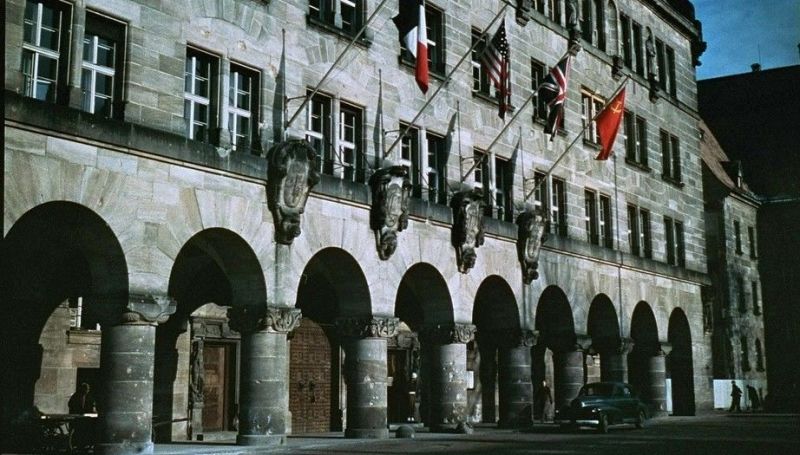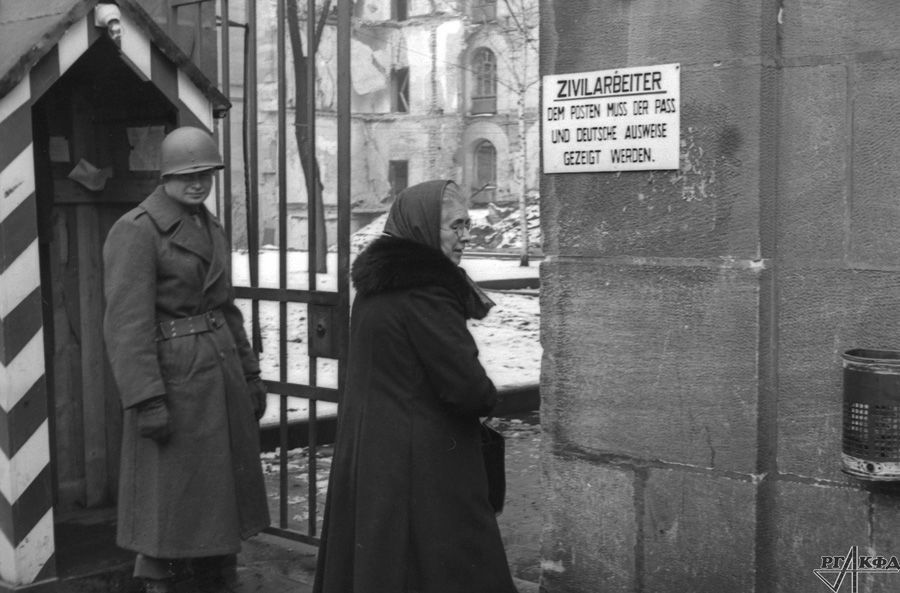When the organisers of the tribunal were picking the location for the trials, what mattered most was that Nuremberg had its Palace of Justice fully preserved along with its prison. However, they couldn't imagine what it was like to live in a place surrounded by ruins infested with rats, and close to poverty-stricken hungry Germans who were hunting for table scraps and cigarette butts.
Jackson was driving around the city in Hitler's limousine and Ribbentrop's Mercedes
On 17 August, the would-be participants of the trials arrived in Nuremberg from Berlin: Soviet judge Iona Nikitchenko, leading US prosecutor Robert Jackson, his British counterpart Hartley Shawcross, and representative of the French indictment professor André Gros. They were to assess the situation in the city and outline the primary goals in order to launch the proceedings in November.
At first glance, it was indeed the right place to choose. The palace was intact. The Grand Hotel, where most of the personnel could be accommodated, was almost undamaged. Some of the mansions in the suburbs also happened to be intact. Jackson even picked one for himself – one with a tennis court and a concert piano, along with a few cars for administrative use, including Hitler's limousine and Ribbentrop's Mercedes.
Yet, the building and limousines were not enough to work properly. Nuremberg had no working water pipes or sewer systems, no transport or telephone connection, there was no electricity, and instead of stores, there was just a small bit of scalping. Jumping ahead, right until the end of the Nuremberg trials, the Palace of Justice remained almost the only place that was fully equipped with communication services and communal facilities.
American judges Francis Biddle and John Parker were quite at odds with each other, but the administration of the tribunal put them under the same roof of a private house, along with several staffers. Biddle's secretary recalled that they had dreamed the most about electricity, to be able to read and write in the evenings. Judge Biddle himself joked, saying that their challenging work could be made slightly easier if only they could find an electric kettle.
Furniture, utensils, linen, pillows, and other household items were not promptly supplied to the judges' mansions. Food provision was unsatisfactory for the American dignitaries, who were used to seeing milk and eggs on their table every morning.
Biddle wrote a letter of complaint to the army heads, but in vain: the army's resources were stretched.
Meanwhile, what the British tribunal representatives missed the most was not eggs or milk, but good alcoholic drinks, which were in short supply.
Once they had to ask the American occupation authorities for them. They felt really awkward about making such a request. Then they started sending letters to their national institutions, even the Foreign Office in London. Having heard about the problem, the chancellor of the duchy of Lancaster dispatched three boxes of gin to Nuremberg and sent whiskey there for his compatriots on a regular basis.
The smell of rotten corpses filled the city for two months after the war had ended
The city itself was a sore sight. Izvestia cartoonist Boris Efimov told a large audience when he was 101 years old: "The museum city, famous throughout the world, the city that had preserved itself through hundreds of years since the Middle Ages. All these buildings, cathedrals, churches - all this was the same as it was then, with the only difference being that the Germans were not wearing medieval camisoles, but rather modern European outfits. The city was famous for the building of children's toys - what could be sweeter and more appealing than children's toys? The name of the great artist Albrecht Durer is associated with Nuremberg. By the way, his house was preserved among the ruins of the city. In general, it was something elevated, attractive. And suddenly Nuremberg appears as something terrible. You cannot imagine what the concrete jungle resembled. Every morning, we had to walk from the hotel where we were settled through a process taking place in the regional court in a building that seemed to have survived on purpose".
The main translator of the American prosecution, Richard Sonnenfeldt, arrived at Nuremberg in October. "Our column squeezed through an endless labyrinth of ruins, past basements, and underground bomb shelters, from where, two months after the end of the war, they smelled of rotting corpses", he wrote. "The acrid stench of long-burnt fires and cordite hung in the sultry summer air. Even in daylight, scabby bony cats chased rats among the crumbling ruins".
The head of the Soviet translators, Oleg Troyanovsky, was in Nuremberg the day before the court hearings. "I arrived in Nuremberg on 19 November, on the eve of the trials", Troyanovsky said in his book. "The city made a depressing impression. Its entire historical centre was turned into ruins as a result of the Anglo-American bombing. No one lived there and could not live there, and only from time to time from the ruins of houses appeared huge rats".
Women rushed to gather cigarette stubs like seagulls
Nuremberg was not dead – some 175,000 people lived, or rather survived there. Eyewitnesses recalled plumes of smoke rising from the ruins all around the city – they rose from the places where people who had lost their houses were taking shelter.
Richard Sonnenfeldt speaks about the state of the city at that time: "Most of the surviving male Germans of military age now became prisoners of war. From time to time you could see an elderly man, or a war veteran missing an arm or a leg, who would stack the bricks gathered from the ruins. Numerous German women of all ages, exhausted, starving, wearing tattered clothes, with unkempt hair, were roaming along the streets trying to survive in the devastated city. I dropped a cigarette stub from the car and three women rushed to get it as if they were seagulls fighting for breadcrumbs".
Sonnenfeldt lived to witness the continuation of the cigarette stub story. He once saw a quarter mile-long queue at the back entrance to the Palace of Justice. The sergeant at the entrance explained to his translator that all those people had come to get a job as janitors.

"Why do they strive to get such menial work", Sonnenfeldt wondered at the time. It turned out that it was not about the job, but about the "cigarette stub concessions". The ashtrays were always filled with stubs at the end of the working day, and the janitors would gather unburned tobacco to later use it to make roll-ups for sale or exchange.
Sonnenfeldt soon realised the true value of money and tobacco in post-war Nuremberg. He was accommodated in an intact cottage on the outskirts of the city. "German hosts were often allowed to stay at the house cellar or garage so they could clean up the rooms and serve the occupants. Most of the hosts, who used to be prosperous traders or specialists, guarded their remaining possessions rigorously. They were paid with soap, coffee, cigarettes, and chocolate. All these things had much more value than regular money in Nuremberg in 1945", he recalled.
Too hungry to think about justice
In their memoirs, tribunal staffers, many of whom were personally engaged in fighting during the war, didn't conceal their curiosity regarding German civilians – what the people were like and why they had brought their country to such a disgraced state.
"My 'landlord' used to keep a book store, which was subsequently ruined, spent loads of time trying to explain to me that he had never been an active Nazi", Richard Sonnenfeldt wrote, continuing:
"Having understood that I'm a Jew and grew up in Germany, he tried to avoid the subject and found other ways to win my favour (…) Like most Germans I spoke to, he ultimately admitted he had been forced to join the Nazi Party to preserve his business. It's interesting to note how many Nazis 'escaped' in post-war Germany along with the Jews!"
The bodyguard of the leading USSR prosecutor Roman Rudenko, a very young man named Josef Hofmann, studied Nuremberg through the prism of its pre-war glory.
"At the famed Nuremberg stadium, Hitler hosted grand military parades", Hofmann writes.
"Among the stands made of grey stone, the central one stood out – from where Hitler watched marching soldiers and stormtroopers during the Nazi gatherings. This is where Hitler called on them to occupy other countries and liquidate entire peoples. During those days, the city was shattered by the tramping of thousands of jackboots. In the evenings, crowds of torch-bearers walked round the city streets yelling and shouting. During the Nuremberg trials, the stadium stood empty, but tourists and many trial participants posed for pictures in the place where Hitler used to stand. In the central stands, a wide dark-blue arrow pointed upward to the place where Hitler usually stood. I also once posed for a picture in this famous stadium", Hofmann continues.
Twenty-two-year-old American Soldier Richard Sonnenfeldt saw a certain unfairness in the situation the civilian population found themselves in.
"Seeing their (German war prisoners') shabby military uniforms, I recognised former Waffen-SS soldiers, Heinrich Himmler's elite units", Sonnenfeldt recounts. "Two months after their demise, they were intact and well-fed, provided with cigarettes and American army rations; they had an opportunity to drink coffee and wash themselves with soap. Meanwhile, their compatriots – civilians – dug up turnips and potatoes, being content with ersatz coffee, making do with substitues for all the rest and fought for cigarette butts thrown from jeeps".
At some point, a correspondent for the American army newspaper Stars and Stripes got into a conversation with a local about the tribunal, which had just started working in the city.
"We are too hungry to think about justice. Death is too great an outcome for these swine", the journalist heard the local say in response.
























